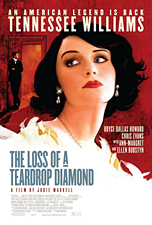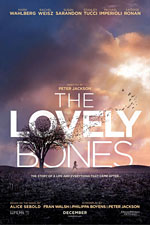
Peter Jackson adapts a literary bestseller, a forgotten Tennessee Williams script is found
film from a queer perspective
Reviews
| KATM media outlets |
| KATM featured weekly |
| Join Us! |
| KATM on RT |
| Vidcast Starring KATM |
| NOTE: THIS SITE ONLY LOADS CORRECTLY WITH EXPLORER AND MOZILLA BROWSERS - SORRY SAFARI USERS! |
| Buy the KATM Book |
Loss & Found:
The Lovely Bones-The Loss of a Teardrop Diamond
Expanded Edition of 1-13-10 KATM Windy City Times Column
By Richard Knight, Jr.
The Lovely Bones-The Loss of a Teardrop Diamond
Expanded Edition of 1-13-10 KATM Windy City Times Column
By Richard Knight, Jr.
| Alice Sebold’s debut novel The Lovely Bones, the story of 14 year-old Susie Salmon who is the victim of a brutal rape and murder who narrates her story and watches those she left behind from a sort of Heavenly in-between struck a chord with readers and became a bestseller in 2002. Now the film version from director Peter Jackson, renowned for The Lord of the Rings trilogy and King Kong, arrives after several release delays. Jackson, who has co-written the script with his usual collaborators, wife Fran Walsh and Philippa Boyens, brings forth an entertaining but strange hybrid – part murder mystery, part gooey teen romance/coming of age story, part philosophy lesson, part family drama. Though none of these parts really hang together (with the family material being the film’s weakest element), the performance of Saoirse Ronan (who played the tattling sister in Atonement) as the pure hearted but luckless Susie anchors the film and will certainly help make it the hit with teenage girls that Paramount is angling it toward. The film is set in December of 1973 in a suburban America not yet familiar with serial killers and pictures of missing kids on the back of milk cartons. Though Susie reminds us of this in voice over at the outset it’s hard to recall such a world once existed or that the eccentric loner character of George Harvey (Stanley Tucci), Susie’s killer and the Salmon’s neighbor (who is given an overbite, thick glasses and a toupee with stringy bangs), wouldn’t scream “murderer” to everyone else on the block. But if the characters on screen (including Michael Imperioli as a rather inept police detective) don’t seem to have a clue to Harvey’s character kinks Jackson makes damn sure the audience does. Tucci is repeatedly shown sitting in the dark in his house or car, engaging in suspicious activities, etc. until finally it dawns on Susie’s dad (Mark Wahlberg) and her sister (Amanda Michalka) that something ain't all there with this guy. This overkill is matched by Jackson’s visual interpretation of pre-Heaven which reflects Susie’s mood – when she’s happy it’s filled with sunshine, green hillsides and blue skies and when she’s sad or angry it’s scary and dark (in one visually arresting sequence, reminiscent of The Nightmare on Elm Street franchise, she recounts Harvey’s other victims). As Susie is emotionally growing up her now fractured family is falling apart – especially Rachel Weisz as her mother who can’t handle her death or the father’s obsession with finding Susie’s killer and takes off to work in a winery. Susan Sarandon as a glamorous granny, cocktail and cigarette in hand, arrives to take charge and add some verve though Jackson’s decision to toss in a comic montage of her bad housekeeping habits (scored to “Long Cool Woman in a Black Dress”) throws the picture out of whack. None of the family stuff really resonates or is deeply explored and it isn’t until we get back to the murder mystery that the movie grinds back into gear. Other than Ronan’s emotionally inviting performance, Jackson’s use of several vintage pieces and a new score by ambient music composer Brian Eno help give the audience the film’s emotional temperature (this works especially well at the outset of the picture). By the fade out of The Lovely Bones, however, with revenge assured, the light beckoning, emotional closure in sight, Jackson might have risked something musically a tad more florid. Certainly by that point audience members – depending on their emotional susceptibility – will either be reaching for the Kleenex or making a mad dash to the exit. +++++++++++++++++++++++++++++++++++++++++++++++++++++++++++++++++++++++ Playwright and gay icon Tennessee Williams collaborated with director Elia Kazan on A Streetcar Named Desire in 1951 and Baby Doll in 1956. The two intended to work together on The Loss of a Teardrop Diamond which Williams penned in 1957 but the project never happened and has gone unfilmed until now. The movie is the feature debut of actor turned director Jodie Markell who, not surprisingly, has long desired to bring this forgotten work by one of our greatest playwrights to light. But though the script contains hints of the lyricism of the best of Williams (“Things that one elects are often circumvented by others” and “You’re the cynosure of all eyes in the room” are just two choice samples of dialogue), this is not the galvanizing, deep fried melodrama of Tennessee Williams at his height but rather, the low fat version. Like that shopworn metaphor, The Loss of A Teardrop Diamond is somewhat tasty, but not particularly memorable. The movie, set in Memphis and its hinterlands in 1923 (which Markell’s team have nicely recreated) focuses on Fisher Willow (Bryce Dallas Howard in an unflattering black pageboy), a southern Jezebel party girl who is a cross between the young Blanche DuBois and a petulant, demanding Scarlett O'Hara (though with Howard in the role she’s not nearly so riveting or bewitching a charmer as those two). Fisher, who has been schooled in Europe is back home at the behest of her aunt (Ann Margret) who holds the purse strings, to attend a series of debutante balls. Partly because of a tarnished reputation caused by her wild ways Fisher hires Jimmy (Chris Evans), who has charm, good looks and breeding but no money, to escort her to the parties. As the Deb balls commence Howard and Evans (who looks smashing in a tux but unfortunately keeps his shirt on) spar in practiced southern dialects, a rival presents herself, and the titled piece of jewelry gets lost (along with the illusions of pretty much all the characters). But other than Ellen Burstyn, who has a few nice scenes as a paralyzed stroke victim, an opium addict looking for sweet release, nothing here really matches the over the top dramatic hallmarks of Williams (or Kazan for that matter). It’s fun to imagine who would have played these star crossed lovers back in 1957 if Williams and Kazan had gone forward with the film – Joanne Woodward and Paul Newman? Natalie Wood and Robert Wagner? Elizabeth Taylor and Montgomery Clift? Perhaps one of those mega watt couplings might have made more with the under nourished material but though I’m glad Markell’s film has given us some unknown Williams to momentarily saver – stacked up against the other films based on the works of Williams of the period – The Rose Tattoo, Cat on a Hot Tin Roof, Suddenly, Last Summer, etc. – it’s no surprise that this script went into the drawer. |





